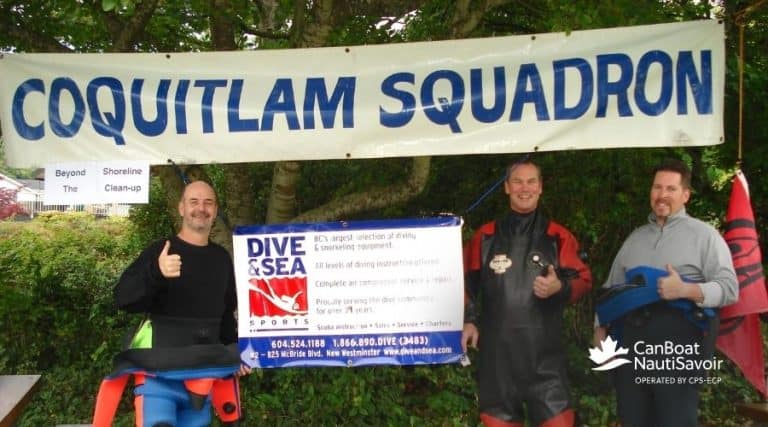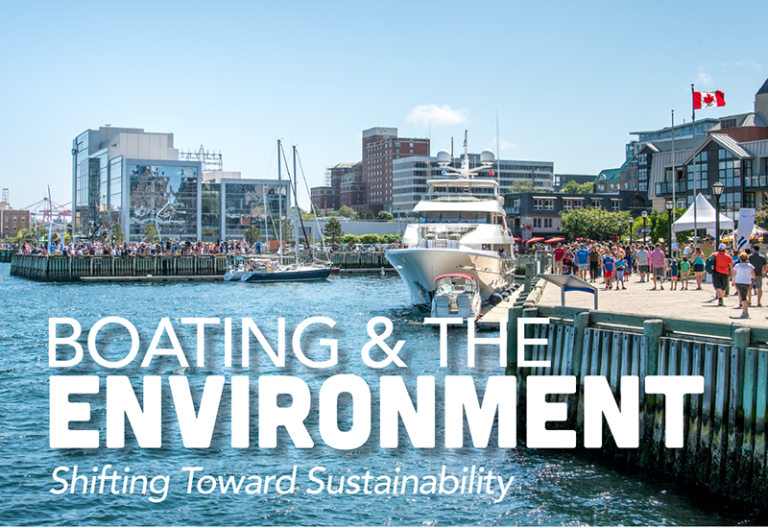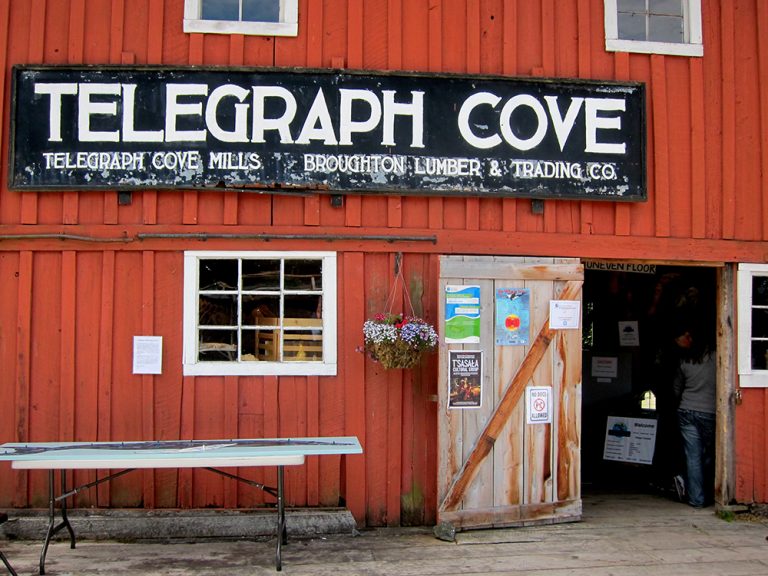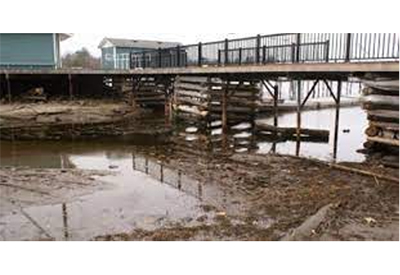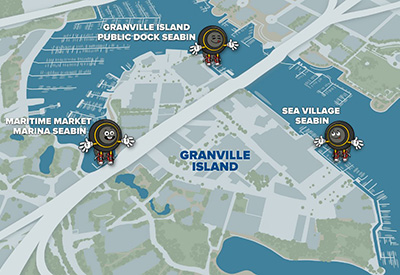Plastic Pickup in Paradise
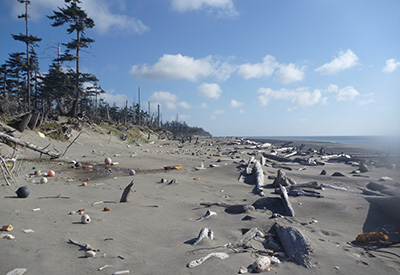
Story and photos by Linda Leitch
We hear about the plastic problem in our oceans all the time. Scientists on the media talk to us about an island of trash the size of Texas that’s formed in the mid Pacific. They show us pictures of turtles caught in six ring beer holders, dolphins caught in nets and dead seabirds washed up with their stomachs full of broken down micro plastics.
For me, it wasn’t until the problem arrived, wind ravaged and sun worn, strewn across my doorstep that that the magnitude of what those scientists were trying to tell us was realized.
The beaches on Haida Gwaii have always been a magnet for the flotsam and jetsam that circles the Pacific. The archipelago sits off shore from the mainland and reaches out into the currents and wild winds of open ocean. Some beaches collect the debris and display it for a while and then it’s simply swept back into the sea to continue its journey, but some beaches here hold on to the debris and do not let it go.
In the years since the Tohoku Tsunami in 2011 we’ve watched with alarm as our favourite areas started to collect devastating amounts of new debris. A beach known simply to the locals as “East Beach” was being hit particularly hard; the belly of this beach is exposed to Hecate Strait and all her wild personality.
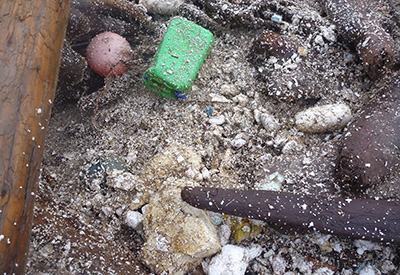 East Beach is our backyard playground. This paradise is where we draw sustenance into our lives. It’s where we hunt deer, collect firewood, pick berries and gather shellfish. This playground extends from the tip of RoseSpit Ecological Reserve all the way through Naikoon Provincial Park and is accessible only by a three-day hike or with the serious use of four wheel drive vehicles.
East Beach is our backyard playground. This paradise is where we draw sustenance into our lives. It’s where we hunt deer, collect firewood, pick berries and gather shellfish. This playground extends from the tip of RoseSpit Ecological Reserve all the way through Naikoon Provincial Park and is accessible only by a three-day hike or with the serious use of four wheel drive vehicles.
Working as weekend warriors, my partner and I began taking heaping truckloads of marine debris off the beach in November of 2013. To date we’ve removed over 70 loads and estimate that we’ve brought in over 36,000 cubic feet of rubbish from our shores. We’ve been able to do this simply with our trusty rusty pick-up truck and a small trickle of funding that was provided to Canada directly from Japan specifically for this purpose.
The debris is dominated by Styrofoam varying in size from blocks that dwarf the truck to tiny microbeads of mess. Behind the Styrofoam are bottles of every shape size and purpose, fishing gear and tiny ground up bits of plastic that maybe used to fit together into something useful but are now an environmental hazard embedding into the shoreline and being eaten by the wildlife.
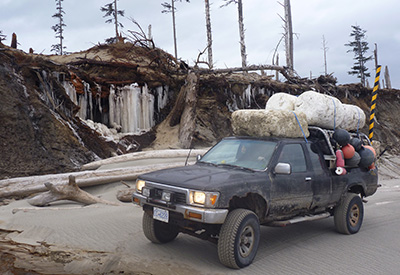 Over time I’ve been forced to realize that though our lone efforts have been infinitely rewarding on a personal level, it’s been an inadequate approach to the problem. Comically I’ve learned the lesson that by simply removing the garbage from the beach today we will not stop more from arriving on the next stormy tide tomorrow. It’s like we’re sailing against the current in a strong headwind.
Over time I’ve been forced to realize that though our lone efforts have been infinitely rewarding on a personal level, it’s been an inadequate approach to the problem. Comically I’ve learned the lesson that by simply removing the garbage from the beach today we will not stop more from arriving on the next stormy tide tomorrow. It’s like we’re sailing against the current in a strong headwind.
The garbage continues to flood in around us and as of March 2015 the trickle of funding has run dry; our project has come to a standstill.
Around the world the problem of plastic pollution is at least starting to get the attention it deserves.
After six years of studying the Gyres across the planet, the nonprofit advocacy group 5 Gyres estimated that there are over five trillion pieces of plastic weighing in at 269,000 tons and it’s just floating aimlessly across our oceans. These numbers merely try to help us develop an image of understanding.
My partner and I don’t have an education backed by science, but we are avid sailors, beach combers, anglers and hunters. Through a practical need we’ve become experts on our surrounding ecosystems, and we can promise you that there is a horror show of irresponsibility unfolding in our ocean.
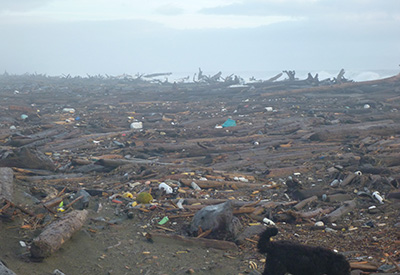 While the debris we’re finding is currently dominated with objects swept into the sea during the Tohoku Tsunami, we’ve also found an enormous amount of garbage washing in from countries all around the Pacific. Inexcusably this debris arrives, marked by its unique culture and language, from countries as close and as far away as Chile, Philippines, Korea, China, Russia, the United States and Canada.
While the debris we’re finding is currently dominated with objects swept into the sea during the Tohoku Tsunami, we’ve also found an enormous amount of garbage washing in from countries all around the Pacific. Inexcusably this debris arrives, marked by its unique culture and language, from countries as close and as far away as Chile, Philippines, Korea, China, Russia, the United States and Canada.
The flotsam and jetsam we find coming on to our shores has been deliberately designed to have a long standing relationship with liquid; Styrofoam, bottles, fishing gear in all its million shapes, oil containers and gas cans, rubber boots, safety equipment and rope. The common theme running through everything we find out there is its durability in water and as a result is usually something that I would find in one form or another aboard or over board of my sailboat.
It’s not too hard to see an immediate connection between the mariner’s life and the type of debris we find; it is, after all, just flotsam and jetsam on a larger scale. Accidents happen and things end up lost to the whims of the water gods. Who hasn’t wondered where that half finished bottle of water went? Maybe you’ve been in the unfortunate situation of needing to cut loose your tackle? And believe me, admit it or not, way too many people lose their shoes!
 As a cruiser making a difference can have varying degrees of complexity, but no matter what extreme we bring it to, we are definitely poised to make a big difference for the health of our waterways.
As a cruiser making a difference can have varying degrees of complexity, but no matter what extreme we bring it to, we are definitely poised to make a big difference for the health of our waterways.
Simply by minimizing our impact while enjoying the water is the best place to begin. I don’t feel like reiterating the basic rules of the 3 R’s – Reduce, Reuse, and Recycle; we’ve all heard it and should be able to chant it in sing song elementary school voices. However if you walk around your vessel with this concept in mind you’ll find many things that can be changed.
Boaters are also in a great position to clean the areas we love so much.
A lot of garbage adrift in our water lands on remote beaches that are only accessible to a small group of users, and that’s us. Though it won’t stop the problem and more garbage might arrive, cleaning the garbage from these areas will at least take a little bit of the problem out of circulation.
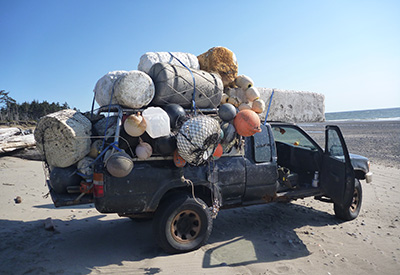 In an effort to keep our project on East Beach rolling we’ve made a “gofundme” page and we’ve had excellent support from family, friends and community members. This is just a temporary solution and not nearly enough to tackle the enormity of the issue but any help is always welcome.
In an effort to keep our project on East Beach rolling we’ve made a “gofundme” page and we’ve had excellent support from family, friends and community members. This is just a temporary solution and not nearly enough to tackle the enormity of the issue but any help is always welcome.
http://www.gofundme.com/noutx0
Photo Captions
Photo 1 – Haida Gwaii is a Pacific Northwest island paradise but ocean currents are bringing marine debris in amazing quantities.
Photo 2 – Plastic never degrades, it just breaks into smaller and smaller bits.
Photo 3 – The trusty rusty truck that has carried out some 70 loads so far.
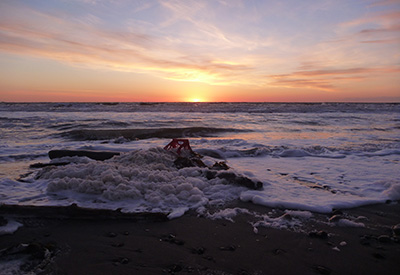 Photo 4 – The dog just made it into the shot, giving this some sense of scale.
Photo 4 – The dog just made it into the shot, giving this some sense of scale.
Photo 5 – Driftwood is everywhere as you would expect, but it catches the debris.
Photo 6 – It may look like a lovely day on the beach but…
Photo 7 – The tidelines deliver an ever-changing landscape of debris but we have to keep making the effort to keep it out of the oceans.


